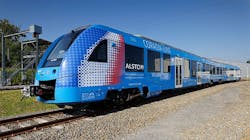Alstom, Liebherr to partner on optimizing H2 systems for Railway Mobility
Alstom signed a collaboration agreement with Liebherr – Aerospace & Transportation SAS that will aim to optimize hydrogen systems. This will include improving the durability and reliability of fuel cells, boosting power density and decreasing costs.
Alstom will leverage Liebherr group’s experience in fuel cell technology for automotive and aerospace applications. As a supplier of turbochargers for fuel cell system integrators, Liebherr will contribute to reducing emissions from rail transport.
Alstom France’s President, Jean-Baptiste Eyméoud said, “Alstom has made sustainable mobility one of the pillars of its strategic plan Alstom in Motion 2025. Our ambition is to accelerate the adoption of hydrogen in the rail industry and to develop innovative solutions in the context of the greening of heavy mobility, including regional trains, shunting locomotives and freight locomotives. To develop a hydrogen ecosystem, particularly in France, we need to mobilize the public authorities and all the players in this sector. As in many fields, we are innovating with structuring partnerships: SNAM, Plastic Omnium, Hynamics, Eversholt and now Liebherr.”
The latest collaboration with Liebherr, adds to the development of Alstom's hydrogen business. Alstom also signed an agreement with natural gas transport firm Snam in 2020 to develop hydrogen trains and related infrastructure.
About the Author
EnergyTech Staff
Rod Walton is head of content for EnergyTech.com. He has spent 17 years covering the energy industry as a newspaper and trade journalist.
Walton formerly was energy writer and business editor at the Tulsa World. Later, he spent six years covering the electricity power sector for Pennwell and Clarion Events. He joined Endeavor and EnergyTech in November 2021.
He can be reached at [email protected].
EnergyTech is focused on the mission critical and large-scale energy users and their sustainability and resiliency goals. These include the commercial and industrial sectors, as well as the military, universities, data centers and microgrids.
Many large-scale energy users such as Fortune 500 companies, and mission-critical users such as military bases, universities, healthcare facilities, public safety and data centers, shifting their energy priorities to reach net-zero carbon goals within the coming decades. These include plans for renewable energy power purchase agreements, but also on-site resiliency projects such as microgrids, combined heat and power, rooftop solar, energy storage, digitalization and building efficiency upgrades.
